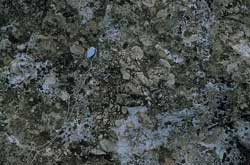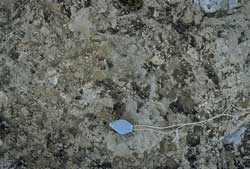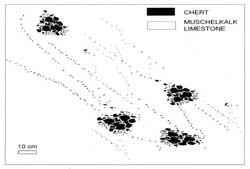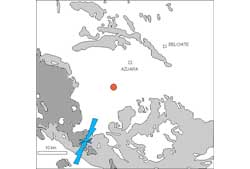
Image A: Shattered chert nodule embedded in Muschelkalk limestone
|

Image B: Flow lines of white chert splinters
|
| Near the village of Monforte de Moyuela at the SSW rim of the Azuara structure, chert nodules in Muschelkalk limestones show very peculiar deformations. The nodules are heavily shattered, fragmented down to millimeter-sized sharp-edged splinters and partly even pulverized (Image A). From these shattered nodules, flow lines of miniature chert splinters run into the limestone as shown in Image B and, for reasons of clarification, in the sketch of Image C. The area interspersed with the flow lines is of the order of some 100 square meters. A statistical analysis of the strike of the flow lines shows a distinct maximum pointing to the center of the impact structure (rose diagram in Image D). |

Image C: Sketch of Muschelkalk – chert flow texture
|

Image D: Midpoint of rose diagram (strike of flow lines) corresponds to the location of Monforte de Moyuela
|
|
A diagenetic origin of this peculiar texture can clearly be excluded, and we suggest a short-term shock-induced fragmentation and fluidization of the Muschelkalk limestones and the embedded chert nodules. A relation may be seen to the acoustic fluidization proposed as possible mechanism to enable impact crater collapse in the modification stage (H. J. Melosh (1989): Impact Cratering. A Geologic Process).
|










































































